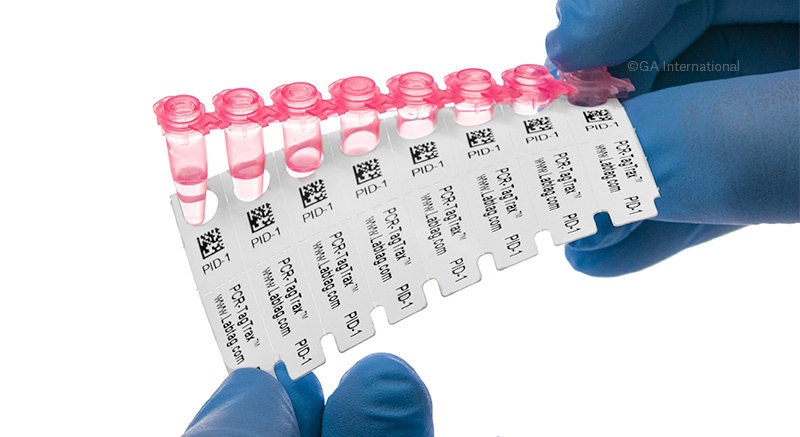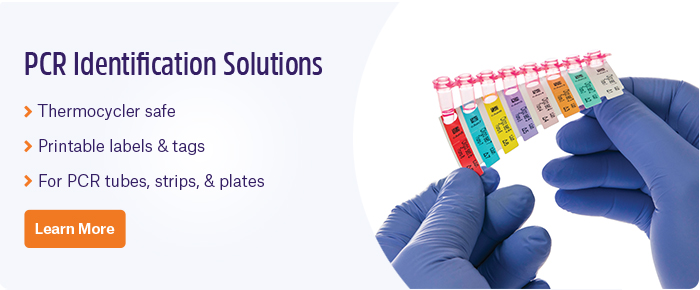 Polymerase chain reaction (PCR) is one of the most commonly performed laboratory procedures. This technique, used to amplify DNA or RNA sequences, is integral to a host of industries and environments, including healthcare, research, forensics, and agriculture. This powerful technique can be used to measure levels of gene activation, discover mutations in samples from patients with cancer, and identify sources of bacterial infection. However, despite recent advances in PCR technology, the problem of labeling PCR tubes remains.
Polymerase chain reaction (PCR) is one of the most commonly performed laboratory procedures. This technique, used to amplify DNA or RNA sequences, is integral to a host of industries and environments, including healthcare, research, forensics, and agriculture. This powerful technique can be used to measure levels of gene activation, discover mutations in samples from patients with cancer, and identify sources of bacterial infection. However, despite recent advances in PCR technology, the problem of labeling PCR tubes remains.
The challenge of labeling PCR and qPCR tubes
Labeling PCR tubes is a difficult task. For basic PCR protocols that use 0.2 ml tubes, there is limited room on which to handwrite legibly, either on the top or side of the tube. Tube strips further limit the writable area, with each tube connected to the next one in the strip. Even with small fine-tip markers, writing becomes illegible and smudges easily, a problem further aggravated during each PCR cycle, which generates temperatures as high as 95°C (203°F). Labeling PCR plates can also be a nightmare. Plastic covers used for these plates afford little room for labeling and must be removed if a sample is needed to verify the identity of the fragments generated. These covers are also not tailored for labeling purposes, as the surface is bumpy once it is affixed to the top of the plate. Altogether, this makes labeling PCR reaction tubes inefficient and time-consuming.
A new method of labeling PCR tubes
The new patent pending PCR-TagTrax™ lets you label PCR tubes with more information than either handwriting or label dots can provide. Its flexible design allows you to tag individual PCR tubes or strips containing up to 8 tubes at a time. You can also use several tags folded into a stacked booklet or in a fanfold configuration to store even more information. Adhesive-free and glove-friendly make the tags easy to use. The flag design of this PCR Sidekick provides a bird’s eye view of your labels that can be seen immediately upon opening the thermocycler, without the need to pull out and read each tube or plate. You can label your samples immediately after you’ve finished preparing the plate, as the PCR-TagTrax–tagged samples can be amplified without losing label integrity or legibility, or interfering with the thermocycler. With a perforation line down the middle, PCR-TagTrax can be used as a stand for your labels, making it easy to label your samples, run them, then store them in the refrigerator or freezer. The tear away flap can also be used to keep a record of your plates and samples, making them easier to organize for storage. Printable with all common thermal-transfer barcode printers, the label can be marked with alphanumeric text, serialized numbering, as well as 1D and 2D barcodes.
Research and healthcare made better by PCR-TagTrax
As PCR tubes are notoriously difficult to label, errors can occur frequently. Mislabeled tubes represent a huge cost to the science and healthcare industry; an error in PCR testing can cost hospitals upwards of $712 per sample, resulting in hundreds of thousands of dollars in unnecessary costs.1 For research labs, this means the loss of potentially irreplaceable samples, in addition to expensive PCR reagents and time. For clinical labs, the consequences can be even more severe if a patient receives an inaccurate PCR test result. PCR-based tests, like those used to detect genetic mutations in cancer or to identify infectious pathogens, are often used to guide therapy options; the life of the patient can depend on receiving an accurate test result to choose the best therapy. An error could mean that the patient does not receive appropriate treatment and/or receives an unnecessary and potentially harmful therapy. Retesting may also be required, necessitating diagnostic procedures that put patients at risk.2
These types of PCR errors can be averted by using PCR-TagTrax. It makes labeling small PCR tubes efficient and cost-effective, providing a series of options for tagging, tracking, and storing these challenging samples. There are many additional benefits to using this PCR Sidekick, including:
- Adhesive-free, glove-friendly design for ease of use
- Versatile design allows tubes, strips, and plates to be tagged in a variety of configurations and styles
- Identification of PCR samples with more information than cap dots and tube side rectangular labels combined
- Quick, bird’s eye view of all printed information upon opening the thermocycler lid
- Able to withstand a wide range of temperatures, from –196°C to +150°
- Thermal-transfer printable, allowing the labels to be printed on with barcodes for easy tracking
- Available in a variety of individual colors or multicolor for easy and convenient color coding
- Perforation line allows the tag to serve as a stand for storage in laboratory refrigerators and freezers
LabTAG by GA International is a leading manufacturer of high-performance specialty labels and a supplier of identification solutions used in research and medical labs as well as healthcare institutions.
References:
- The Problem of Mislabeled Specimens. Northfield, IL; 2010.
- Kahn SE. Specimen Mislabeling: A Significant and Costly Cause of Potentially Serious Medical Errors. Brønshøj, Denmark; 2005.



